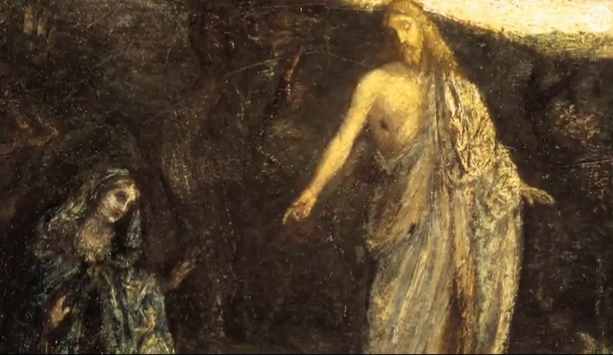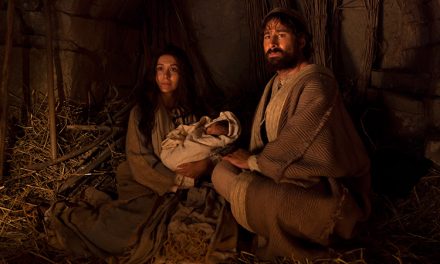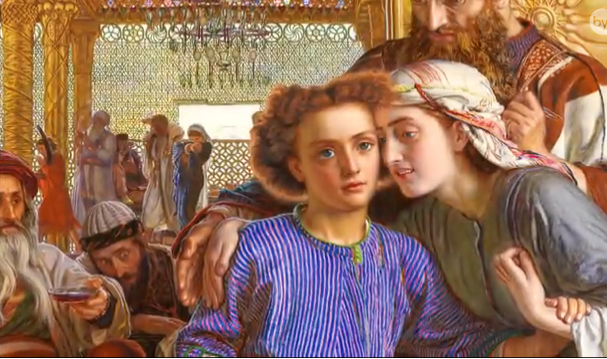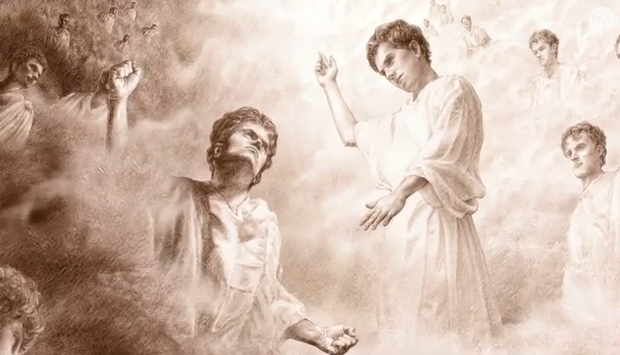Eyewitness accounts of those who touched the risen Savior just days after His crucifixion and burial, sustain the belief of a physical union of Jesus’ body and spirit. Whether He is on the road to Emmaus or teaching at the temple in the New World, the appearance of Jesus Christ declares His triumph over death as He invites all to come unto Him.
JOHN S. TANNER: For believers, it’s the Resurrection—an event that might have taken place here—that is the crowning event of Jesus’ ministry. It sets him apart from all those who have come before. There’d been preachers; there’d been prophets; there had been healers; but none of them had the power to lay down their life and take it up again. It was the Resurrection that provided the founding doctrine for all Christianity. Without it, Christianity would be a series of beliefs, and it would have inspiring stories and an inspiring message about how to live a good life, but it wouldn’t be Christianity as we know it.
ANDREW SKINNER: But you know, John, with the Resurrection of Jesus Christ, we possess the message for eternities. It is the center of everything we believe in. It’s the lynchpin of our faith. And yet ironically it’s from mainstream Christianity and some New Testament scholars that much of the skepticism we see emerges.
GAYE STRATHEARN: But all this doesn’t change the witness of some women from an obscure Roman province, that on a beautiful spring morning much like today, 2000 years ago, something happened that had never happened before.
 JOSEPH FIELDING MCCONKIE: What is resurrection? Now it’s an interesting thing that the word resurrection is not found in the Old Testament. And in the entirety of the Bible, you and I can read the Bible from Genesis to Revelation, and we’ll never get a definition of resurrection. Now this is where the restored gospel becomes so marvelous. You go to Alma for instance, and Alma’s the one that tells you that resurrection is this inseparable union of body and spirit. Now as simple as that is, it, it becomes the foundation upon which every other gospel truth rests.
JOSEPH FIELDING MCCONKIE: What is resurrection? Now it’s an interesting thing that the word resurrection is not found in the Old Testament. And in the entirety of the Bible, you and I can read the Bible from Genesis to Revelation, and we’ll never get a definition of resurrection. Now this is where the restored gospel becomes so marvelous. You go to Alma for instance, and Alma’s the one that tells you that resurrection is this inseparable union of body and spirit. Now as simple as that is, it, it becomes the foundation upon which every other gospel truth rests.
RICHARD D. DRAPER: The most indigestible lump in the theological pudding of the ancient saints is the idea of a corporeal or a bodily Resurrection of the Lord. By the 4th century the tension actually resolves itself, unfortunately in the direction of a non-corporeal resurrection. And these scholars therefore absolutely deny the corporeal Resurrection of the Lord, that it was apologetics.
Generally the explanations fall into 3 categories, okay. The first one centers on the power of the personality of the Lord. So charismatic was He that the early disciples simply could not get over the fact of His death, and, as a result, internal tension, group tension, and so on created a sort of a neurosis. The outcome of that was a kind of broad-based hallucination in which they believed that they had seen Jesus. The second comes from the idea that Jesus actually didn’t die on the cross, but rather He was resuscitated in the tomb, made His appearances and then left the scene. The third one, interestingly enough, follows the Jewish scenario, that is to say the one we find in Matthew 28, where the Jews paid the guards to say that Jesus’ disciples came and stole the body and then the disciples circulated these stories about the Resurrection.
JOHN S. TANNER: There’s been a great deal of attention focused in on the disparities in the Gospels’ account of the Resurrection.
ANDREW SKINNER: Questions like, was there one angel or two at the tomb, was Peter alone when he saw the resurrected Lord or was he with another apostle, the Apostle John? These kinds of questions have caused some New Testament scholars to regard the evidence for the Resurrection as “confused and fragile.” And I suppose that if we only had the New Testament accounts, some of that confusion would be understandable.
JOHN S. TANNER: Right, but if we add the modern revelation, if we add the Book of Mormon, if we add the Doctrine and Covenants, if we add the testimony of modern prophets, then the evidence for Jesus’ literal, physical Resurrection as a glorified being is just overwhelming.
ANDREW SKINNER: I like the words of one profound student of the scriptures, who said, “There is no more fact or event in history of which he is more sure than the physical, bodily Resurrection of the Lord Jesus Christ.” And that student just also happens to be a prophet of God, Ezra Taft Benson.
RICHARD D. DRAPER: We have very, very good evidence from the early church that there really was a historical event that happened here. For example, there are those who actually saw and heard the Lord. The two men on the road to Emmaus, the ten disciples. Paul says that there were actually 500 brethren that saw Him at once. And then of course we have Paul himself that sees the Lord.
But there is another class of witnesses, and these are those who not only saw and heard the Lord, but also those who touched Him. The women at the tomb, who were sent to tell the apostles, meet the Lord on the way. And it is interesting that they fall down and they touch the feet of Jesus and they worship Him. But the Greek is very strong there. The word is kratao, which means to seize or grasp. This wasn’t a little polish or a brush. They touched the Lord; they clung to the Lord.
And then of course we’ve got Thomas himself, you know—unless I touch the wounds I will not believe. So when the Lord shows up, what does He say? Here I am, there’s the wound in the side; there’s the hands. So Thomas also has tactile witness. But interestingly enough, one that we often miss, and it’s due to a translation problem, is Mary of Magdala. The King James text of course has Jesus appearing to her at the tomb, and, apparently, the way the King James text version goes, is that she made a move toward Him and Jesus says, “Touch me not; for I’m not yet ascended to my Father” in Heaven (John 20:17). The grammar of the Greek suggests that there’s a better translation. We’ve got a present imperative coupled with a negative, which means, “Cease doing what you are now doing.” And with her, the Greek word is not kratao, to seize or grasp, but rather it is hopto, to embrace. I believe what Jesus is doing is saying, I must be about my Father’s work. This is a very tender moment, but you must cease embracing me now so that I can go and do what the Father wants me to do.
And therefore, the women, Thomas, perhaps the other apostles, and Mary, have a threefold witness. They knew, because they had seen the Lord. And what’s the aftermath of that? Take a look at Peter, who goes forth in boldness. And what is the central message? We preach unto you, Christ crucified and Christ resurrected from the dead. That is the message.
JOSEPH FIELDING MCCONKIE: The two greatest stories in earth’s history, as far as the Gospel of Jesus Christ is concerned, would be the story of Christ’s birth, the reality of the— His divine sonship, and the reality of His Resurrection, which is the crown on His ministry and that illustrates that He is indeed God’s Son. And in both instances women play a prominent role as special witnesses of those events.
VIRGINIA PEARCE: I love the interchanges between the Savior and the women in the New Testament. The whole history of women on this planet is pretty convoluted, and we’ve gone through some difficult times in terms of who we are and how we’re to be treated. And even though here we have a book that has also survived through hundreds of years, it still is impossible to erase that love and respect. He’s never condescending, He is gentle, He is firm, He is respectful. He teaches them every doctrine that He teaches the men. There’s no difference for Him, and why would there be? This is someone who is the God of this world, who came to save everyone.
ALAN K. PARRISH: One might ask, why, why is He concerned almost more as to the treatment, the understanding, the loving of the women, than He is to the Twelve? My own conclusion would have to be that whether in our law and custom or in ancient Israel, a man’s responsibility for his home—in this case His mother and others near and dear to him, seems to dominate. They’re the ones then— the women are the ones that are instructed to go and tell Peter and the rest of the brethren what had happened. And then they come and witness that Christ’s body is gone.
VIRGINIA PEARCE: All of the exchanges with women—Martha, Mary, and then finally the exchange at the tomb, as He appears to Mary first in His resurrected state, and asks her to convey the message. I just—I don’t know whether it’s possible for men to understand what that does for women, the kind of dignity without patronizing that it gives us, each of us.
JUAN HENDERSON: The apostles were gathered together in Jerusalem. And at this time, many things had happened. Peter had denied Christ, and Jesus had been crucified. And so they were all huddled together in one place.
RICHARD ANDERSON: In a setting such as that, the apostles were still together, counseling, trying to rebound—think through what on earth had happened. And the disillusionment of all of their dreams and plans. Because they didn’t fully understand the prophecy and how it would be fulfilled when Jesus said He would leave them.
CECILIA M. PEEK: In basically every one of the Gospel accounts, it is women who first discover the empty tomb and first encounter the risen Jesus.
JUAN HENDERSON: Mary and the other women had gone to the tomb, and the tomb was empty.
ALAN K. PARRISH: And in their going, at first—disappointment— He isn’t there. But angels are, and those angels give them such reassurance and such confidence. It must have been a beautiful, beautiful moment and experience. And then the instruction to go and tell the brethren.
MICHAEL RHODES: They go back to the disciples; they tell them, and the apostles simply find this unbelievable. They laugh at the women.
CLYDE WILLIAMS: This has never happened before. They’re still trying to shed the old notions of a millennial Messiah who’s going to come in a triumphal way, and still trying to bring together this notion of a Resurrection.
MICHAEL RHODES: But at least Peter and John then run to the tomb. And John is faster than Peter. You know, Peter’s the older man; he can’t keep up. They arrive at the tomb. But John, recognizing Peter as the senior apostle, waits. And Peter catches up, out of breath, you can kind of imagine. He looks in the tomb, and as he looks in the tomb, details like the grave clothes are carefully folded in place there where Christ was.
JUAN HENDERSON: And I really think that this was the beginning of them starting to believe what Jesus had said, just an inkling of light.
CECILIA M. PEEK: Another example of this kind of beautiful detail that we get, is the story of the disciples on the road to Emmaus, who are walking along, recalling the recent events and sorrowing over those events. And then Jesus Himself appears to them, though they don’t initially recognize Him.
CLYDE WILLIAMS: We learn something about resurrected beings here. A resurrected being does not have to appear always in full glory. He can come—in this case—I don’t think—they don’t recognize Him, cause He’s got on some kind of a cloak and pulled it around His face. I think He’s talking with them and discussing, and of course they’re surprised He doesn’t seem to know about the events, so He’s playing on a bit with them here.
CECILIA M. PEEK: Eventually He, after having some conversation with them, suggests that He’s going to go off. They invite Him to come in with them, and they continue this exchange. They seem quite surprised, they say, where have you been, how can you not know of the events of recent days? And of course He is the main participant in the events of recent days and knows very well what has happened, and is gradually bringing them to the point where they will fully realize what had happened as well.
CLYDE WILLIAMS: They’re intrigued with His discussion and His knowledge of the scriptures. And then of course when He breaks the bread with them and serves it to them, they see who He is—they recognize Him, rather, as the Savior, and He disappears out of their midst. What touches me in terms of this witness of this Resurrection is that they didn’t say, As He was opening unto us the scriptures, did not our heads within us swell, as He opened to us the scriptures. It was, Did not our hearts within us burn, as He opened unto us the scriptures. They felt something. It was not just what they saw, it was what they felt that really touched them and was a witness. Sometimes we think we have to see to know. They felt something, and they knew even as much by what they felt. That’s important for us. We tend to sometimes dismiss those spiritual promptings. They didn’t, and that’s important.
JOHN S. TANNER: Peter will later say that:“We have not followed cunningly devised fables,” but we are sure witnesses, we are “eyewitnesses of his majesty”(1 Peter 1:16). Now He’s probably talking about the transfiguration there. But they are eyewitnesses, they’re sure witnesses. And one of the things that they get to be witnesses of, and it’s very important they do, is of the physicality of the Resurrection.
CLYDE WILLIAMS: When the Savior appears to the disciples, of course their reaction at first is with fear. They’re terrified. They think they’re seeing a spirit. Clearly they still don’t yet quite comprehend this full notion of a resurrected being. And we don’t fault them, because this has never happened before. But to help ease their fears, Luke records—and it’s so significant—that He asks them to come forward and to feel His hands and His feet.
JUAN HENDERSON: He wanted to reassure them that He was the same Christ that was with them for the 3 ½ years in His mortal ministry, to let them know that He was a resurrected body, a resurrected Savior.
CECILIA M. PEEK: And to further underscore the very physical reality of His resurrected state, He even eats something in front of them, to demonstrate that He still has a body. And He says very explicitly: “A spirit hath not flesh and bones, as ye see me have” (Luke 24:39).
MICHAEL RHODES: These ten apostles—Thomas is missing at this point—can now literally say, I know that Jesus Christ rose from the dead. I touched him; I saw him; I saw him eat. And then a week later, the apostles are together again, and Thomas is there this time. And Thomas had said, Unless I put my fingers in the holes in His hands and thrust my hand into the hole in His side, I will not believe. And Christ appears and He says, Come on, Thomas (see John 20:25–27).








